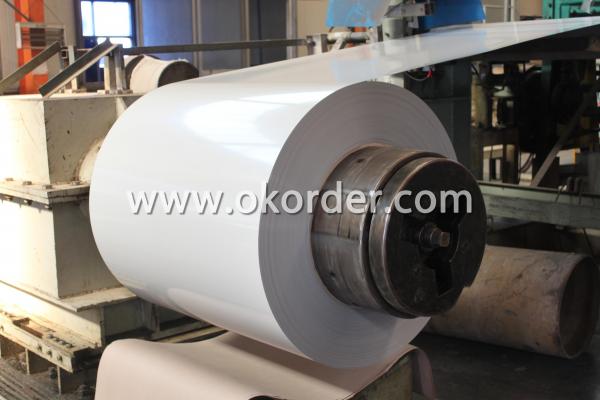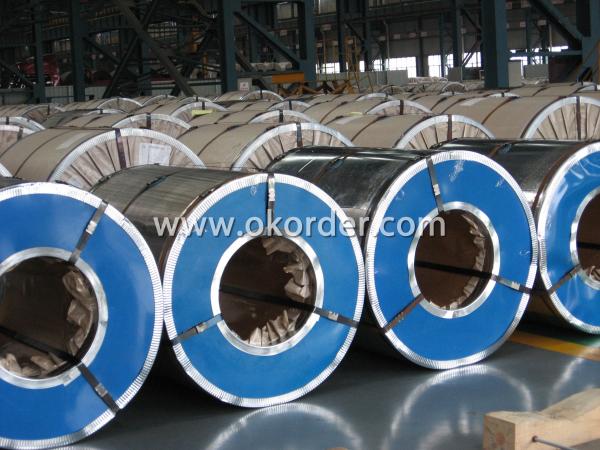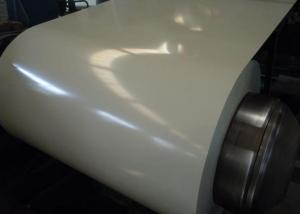Cheap Prepainted Aluzinc Steel Coil-ASTM A755M
- Loading Port:
- China Main Port
- Payment Terms:
- T/T or L/C
- Min Order Qty:
- 50mt m.t.
- Supply Capability:
- 100,000 mt/year m.t./month
OKorder Service Pledge
OKorder Financial Service
You Might Also Like
Cheap Prepainted Aluzinc Steel Coil-ASTM A755M
With GL as base metal, after pretreatment (degrease and chemical treatment) and liquid dope with several layers of color, then after firing and cooling, finally the plate steel is called pre-painted aluzinc steel. Pre-painted Aluzinc steel is good capable of decoration, molding, corrosion resistance. It generally displays superior workability, durability and weather resistance.
General Information Of Cheap Prepainted Aluzinc Steel Coil-ASTM A755M
Thickness | 0.23-1.2mm (BMT) |
Width | 900-1250mm |
Alu-zinc Coating | 50-150g/m2 |
Internal Diameter | 508mm or 610mm |
Color | According to RAL color fan |
Coil Weight | 4-8MT |
Quality | Commercial and structural quality |
Paint | Polyester paint for topside, epoxy for reverse |
Standard | JIS G 3322, ASTM A755M, EN 10169 |
Package | Full wrapped with anti-damped paper inside, iron sheet wrapped outside, and bundled by iron strips |
Base Steel Grade | SGCC, SGCD, DX51D+Z DX52D+Z; S200GD, S220GD, S280GD,S350GD,CS,FS,SS |
Technical Data Of Cheap Prepainted Aluzinc Steel Coil-ASTM A755M
Chemical Composition | C | Si | Mn | P | S |
0.04-0.06% | 0.01-0.03% | 0.18-0.22% | 0.014-0.016% | 0.006%-0.009% |
Technical Data Of Cheap Prepainted Aluzinc Steel Coil-ASTM A755M
Yield Strength | (Mpa) 280-320 |
Tensile Strength | (Mpa) 340-390 |
Elongation | 20%-30% |
Reverse Impact | 9J |
T-bending | ≥2T |
Pencil Hardness | ≥2H |
Duration Of Salt Spray Test | 500 H |
Bending At 180 Degree | No crack, purling and fraction |
Application Of Cheap Prepainted Aluzinc Steel Coil-ASTM A755M
It can be widely used in transportation, light industry, civil usage and farming. It is also the perfect building material in construction for making steel roofing, corrugate sheet, sandwich panel for wall or roofing, facade wall,shutters and home appliance.


Packaging & Delivery Of Cheap Prepainted Aluzinc Steel Coil-ASTM A755M
The packing of coils consists of anti-damp paper, PVC film, hardboard paper, steel box, strapped with steel strips, fitted with locks and edge protectors and guarantees the optimal condition of the delivered goods. Each coil can be additionally fitted with wooden/steel skids(eye to the side) or wooden pallets(eye to the sky).
Delivery Detail: As customer requested

- Q:I am a beginner and have a slow to average swing speed. Should i get graphite or steel shafts for my irons and does it make a difference?
- How about graphite in your 3,4,5 irons and lightweight steel in your scoring clubs. You can swingweight them all the same so you will have a consistent feel through out the entire set and you will get extra help getting the ball in the air with the long irons and extra stability in the scoring clubs. And you save money by not having to put graphite in the entire set. As a beginner the clubs you get now may not suit you as you progress and your swing evolves so keep this in mind when buying a set of irons.
- Q:What are the factors affecting the strength of steel coils?
- There are several factors that can affect the strength of steel coils. 1. Steel Grade: The type and quality of the steel used in the coils plays a significant role in determining their strength. Different steel grades have varying levels of carbon content, alloying elements, and heat treatment processes, which can impact the overall strength and durability of the coils. 2. Manufacturing Process: The way in which the steel coils are manufactured can also affect their strength. Factors such as the temperature and duration of the heat treatment, the rolling and annealing processes, and the level of cold working can all influence the final strength of the coils. 3. Thickness and Width: The thickness and width of the steel coils can affect their strength. Thicker coils tend to be stronger and more resistant to deformation, while wider coils may exhibit variations in strength across their surface. 4. Surface Quality: The condition of the coil's surface, including any imperfections or defects, can influence its strength. Surface defects such as scratches, pits, or corrosion can act as stress concentration points, reducing the overall strength of the coil. 5. Storage and Handling: The way in which the coils are stored and handled can impact their strength. Factors such as exposure to moisture, extreme temperatures, or improper stacking and transportation can lead to deformation or damage, decreasing the strength of the coils. 6. Environmental Conditions: Environmental factors such as humidity, temperature, and exposure to corrosive agents can also affect the strength of steel coils. In harsh environments, the coils may experience accelerated corrosion, leading to a decrease in their strength over time. It is important to consider these factors when selecting and utilizing steel coils to ensure that they meet the required strength specifications for the intended application.
- Q:How are steel coils affected by global trade policies?
- Steel coils are significantly affected by global trade policies as they are subject to various tariffs, quotas, and trade restrictions imposed by different countries. These policies can impact the cost, availability, and competitiveness of steel coils in the international market. Changes in trade policies can lead to fluctuations in demand and supply, impacting the prices and trade volumes of steel coils.
- Q:what do they use to make stainless steel?and can stainless steel be melted again and again without losing it's Specifications
- The basic ingredient is from 11%-30% chromium, however in many stainless steels nickel or manganese are important secondary ingredients. There are two basic types of stainless steels: 1)austenitic stainless steels, and 2)ferritic stainless steels. In austenitic SS the important ingredients are Chromium and Nickel. (Chromium and manganese are occasionally use instead of nickel.) It's important to note that many austenitic SS's contain almost no carbon, so by some definitions they are not steel at all but iron/chromium/nickel alloys. the additions of nickel (or manganese) actually changes the crystal structure of the iron, so the properties of these types are quite different from normal carbon steels. Austenitic SS have very good to excellent corrosion resistance, and fairly good heat resistance. In ferritic stainless steels, the important ingredients are chromium and carbon. Ferritic stainless steels have markedly greater strength than austentitic types. However since they contain less chromium than austenitic types they are only moderately corrosion resistant and are much less heat resistant. Without the addition of nickel and/or manganeese adding more than about 20% chromium tends to make the steel brittle. Most stainless steel is melted under an inert argon atmosphere in an airtight furnace. Melting stainless in open air would preferentially oxidize the chromium, forming slag which would float to the surface of the steel, thus reducing the chromium content. Chromium also tends to react with nitrogen in the air at high temperatures, exposure to nitrogen tends to cause brittleness in stainless steels. As long as the manufacturer keeps careful control of the composition of the metal and the level of impurities during melting, stainless is endlessly recyclable.
- Q:How are steel coils protected from mechanical damage?
- Steel coils are protected from mechanical damage by using various methods such as wrapping them with protective materials like plastic or paper, using suitable packaging and strapping techniques, and storing them in a controlled environment to prevent any potential impacts or collisions.
- Q:What are the dimensions of steel coils used in the mining equipment industry?
- The dimensions of steel coils utilized in the mining equipment sector may differ depending on the particular application and demands. Nevertheless, there are frequently employed standard dimensions. Typically, the width of steel coils used in the mining equipment industry can range from 600mm to over 2000mm. This allows for adaptability in the manufacturing process and guarantees that the coils can be customized to fit different equipment sizes and specifications. Regarding thickness, steel coils employed in mining equipment can range from 1.5mm to 20mm or more. The specific thickness is determined by factors such as equipment type, intended usage, and required durability level. The length of steel coils used in the mining equipment industry can also vary, but usually falls within the range of 1000mm to 6000mm. Once again, this offers flexibility in the manufacturing process and ensures that the coils can be cut to suit the exact requirements of the equipment being produced. It is essential to acknowledge that these dimensions are not fixed and can be tailored to meet the specific needs of the mining equipment sector. Manufacturers and suppliers in the industry can often provide coils in different sizes and dimensions to accommodate the wide array of equipment used in mining operations.
- Q:How are steel coils formed into specific shapes?
- Steel coils are formed into specific shapes through a process called roll forming, which involves passing the coils through a series of rollers. The rollers gradually shape the steel into the desired profile, applying pressure and bending it to the required angles. This allows manufacturers to create various shapes and sizes of steel coils for different applications.
- Q:and is that different from the components of steel
- Making steel is very energy intensive. Mining the raw ore requires a lot of machinery that uses fuel or electricity . Transporting the ore requires a lot of fuel. Refining not only uses a lot of electricity but coal is added to change the iron ore into steel.
- Q:What is the role of steel coils in the production of conveyors?
- The role of steel coils in the production of conveyors is to provide structural support and strength to the conveyor system. Steel coils are used to create the framework and components of the conveyor, ensuring durability and reliability in moving heavy loads. They are the backbone of the conveyor, allowing it to handle various materials and withstand the stresses of continuous operation.
- Q:Got small (.177) bb gun for fun with my son...From the manual:'Steel shot will fire at a higher velocity then lead shot with with the same muzzle energy. As a result, more caution is required when using steel shot because of a greater hazard of ricochet. Lead, because of its lower velocity, usually has less penetrating power and is less likely to ricochet.'Are you agree with that? ;)
- steel is made of iron mainly (and carbon) its density is 7.86 g/cm? approximately. and lead has density=11.4 g/cm?. so, if have same volume and shape steel will have less mass and thus will have greater velocity for same muzzle energy. I agree the manual. for more information on ricochet
1. Manufacturer Overview |
|
|---|---|
| Location | Wuxi, China |
| Year Established | 2002 |
| Annual Output Value | US$1 Million - US$2.5 Million |
| Main Markets | Mid East Northern Europe North America Eastern Asia Africa Eastern Europe Southeast Asia Western Europe Southern Europe |
| Company Certifications | ISO 9001;ISO 14000 |
2. Manufacturer Certificates |
|
|---|---|
| a) Certification Name | |
| Range | |
| Reference | |
| Validity Period | |
3. Manufacturer Capability |
|
|---|---|
| a)Trade Capacity | |
| Nearest Port | Shanghai |
| Export Percentage | 1% - 10% |
| No.of Employees in Trade Department | 50 |
| Language Spoken: | English; Chinese |
| b)Factory Information | |
| Factory Size: | Above 600,000 square meters |
| No. of Production Lines | 10 |
| Contract Manufacturing | OEM Service Offered |
| Product Price Range | Average |
Send your message to us
Cheap Prepainted Aluzinc Steel Coil-ASTM A755M
- Loading Port:
- China Main Port
- Payment Terms:
- T/T or L/C
- Min Order Qty:
- 50mt m.t.
- Supply Capability:
- 100,000 mt/year m.t./month
OKorder Service Pledge
OKorder Financial Service
Similar products
New products
Hot products
Related keywords





























